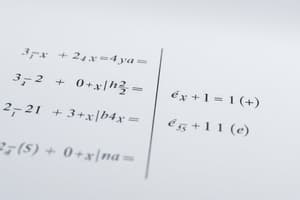Podcast
Questions and Answers
What are the two types of linear equations mentioned in the text?
What are the two types of linear equations mentioned in the text?
- Two-variable and three-variable linear equations
- Two-variable and four-variable linear equations
- Single-variable and triple-variable linear equations
- Single-variable and two-variable linear equations (correct)
Which technique is commonly used to isolate variables in linear equations?
Which technique is commonly used to isolate variables in linear equations?
- Dividing both sides by zero
- Multiplying both sides by a constant
- Taking the square root of both sides
- Isolating one variable by adding or subtracting terms (correct)
What is the first step in solving a single-variable linear equation?
What is the first step in solving a single-variable linear equation?
- Multiplying both sides by the coefficient of the variable
- Subtracting the variable from one side
- Dividing both sides by 2
- Isolating the variable by adding or subtracting constants to both sides (correct)
What method is used to solve two-variable linear equations by solving for one variable in terms of the other and substituting it into the second equation?
What method is used to solve two-variable linear equations by solving for one variable in terms of the other and substituting it into the second equation?
When solving linear equations with two variables using elimination, what is done to eliminate one variable?
When solving linear equations with two variables using elimination, what is done to eliminate one variable?
What is the final step in solving a system of linear equations once you have found the values of both variables?
What is the final step in solving a system of linear equations once you have found the values of both variables?
How does mastering how to solve linear equations benefit problem-solving?
How does mastering how to solve linear equations benefit problem-solving?
Why is studying linear equations crucial in algebra?
Why is studying linear equations crucial in algebra?
Study Notes
Exploring Linear Equations in the World of Math
Linear equations are fundamental to the world of mathematics and are a cornerstone of algebraic thinking. These equations express a linear relationship between two or more variables and are essential in understanding and solving a wide range of problems. Let's dive deeper into linear equations, focusing on their importance and how to solve them.
Linear Equations: Definition and Examples
A linear equation is an expression of the form:
Ax + By + C = 0
where A, B, C are constants, and x and y are variables. In this context, A and B represent coefficients, while x and y represent the unknowns.
Linear equations often come in two flavors:
- Single-variable linear equations, where only one variable appears.
- Two-variable linear equations, where both variables appear.
A few examples of linear equations include:
- 3x + 5y = 10
- 2x - y = 4
- x = 0 (a vertical line)
- y = 1 (a horizontal line)
Solving Linear Equations: Strategies and Techniques
To solve linear equations, we generally want to find the values of the variables x and y that satisfy the equation. Here are some common techniques for solving linear equations:
- Simplifying the equation by combining like terms (adding or subtracting terms that have the same variable)
- Isolating one variable by adding or subtracting terms to move the other variable to one side of the equation
- Checking the solution by substituting back the values of x and y into the original equation
Solving Linear Equations with One Variable
When solving a single-variable linear equation, you can isolate the variable by adding or subtracting constants to both sides of the equation. For example, let's solve for x in the equation:
3x + 5 = 13
-
Subtract 5 from both sides: 3x = 8
-
Divide both sides by 3: x = 8 / 3
Solving Linear Equations with Two Variables
Solving two-variable linear equations can be more challenging. One common technique is to solve each variable separately by using substitution or elimination methods.
- Substitution: Solve for one variable in terms of the other from one equation, then substitute that expression into the second equation to solve for the other variable.
- Elimination: Add or subtract equations to eliminate one variable, then solve for the remaining variable.
For example, let's solve the following system of linear equations:
-
3x + 5y = 10
-
x - 2y = 4
-
Solve the second equation for x: x = 4 + 2y
-
Substitute x in the first equation: 3(4 + 2y) + 5y = 10
-
Solve for y: 12 + 6y + 5y = 10 11y = -2 y = -2/11
-
Substitute the value of y back into the expression for x: x = 4 + 2(-2/11) x = 4 - 4/11 x = 41/11
So the solution to this system of linear equations is x = 41/11 and y = -2/11.
Linear equations are essential tools for solving various mathematical problems, and their study is crucial in understanding the foundations of algebra. As we have seen, solving linear equations can be done through various strategies, including simplifying, isolating variables, and using substitution or elimination methods. With practice and patience, mastering how to solve linear equations will open up the world of mathematical problem-solving and help you better understand the complexities of the mathematical landscape.
Studying That Suits You
Use AI to generate personalized quizzes and flashcards to suit your learning preferences.
Description
Explore the world of linear equations in algebra, learning about their definition, examples, and solving strategies. Dive into single-variable and two-variable linear equations, understanding techniques such as simplification, isolation, substitution, and elimination.





